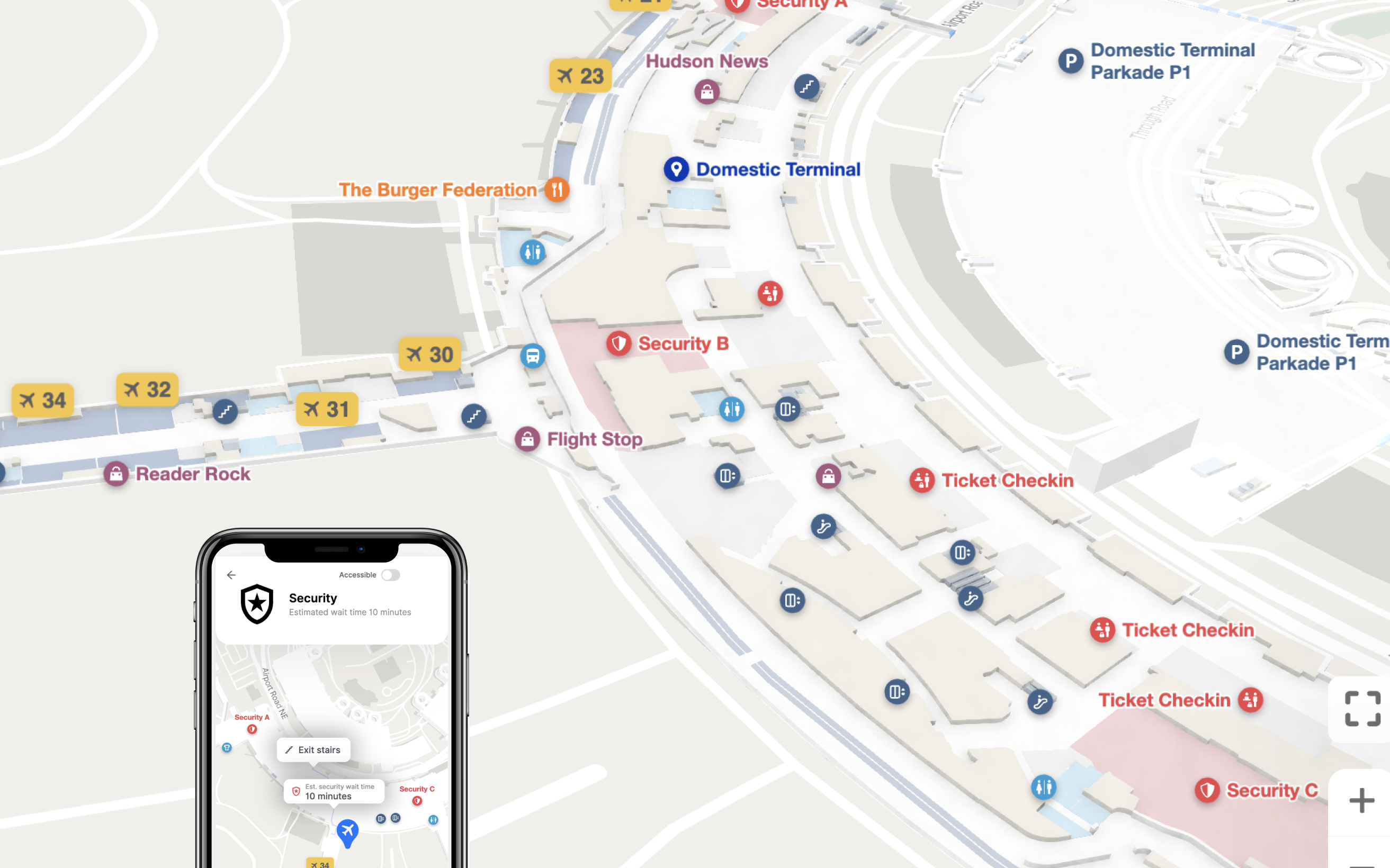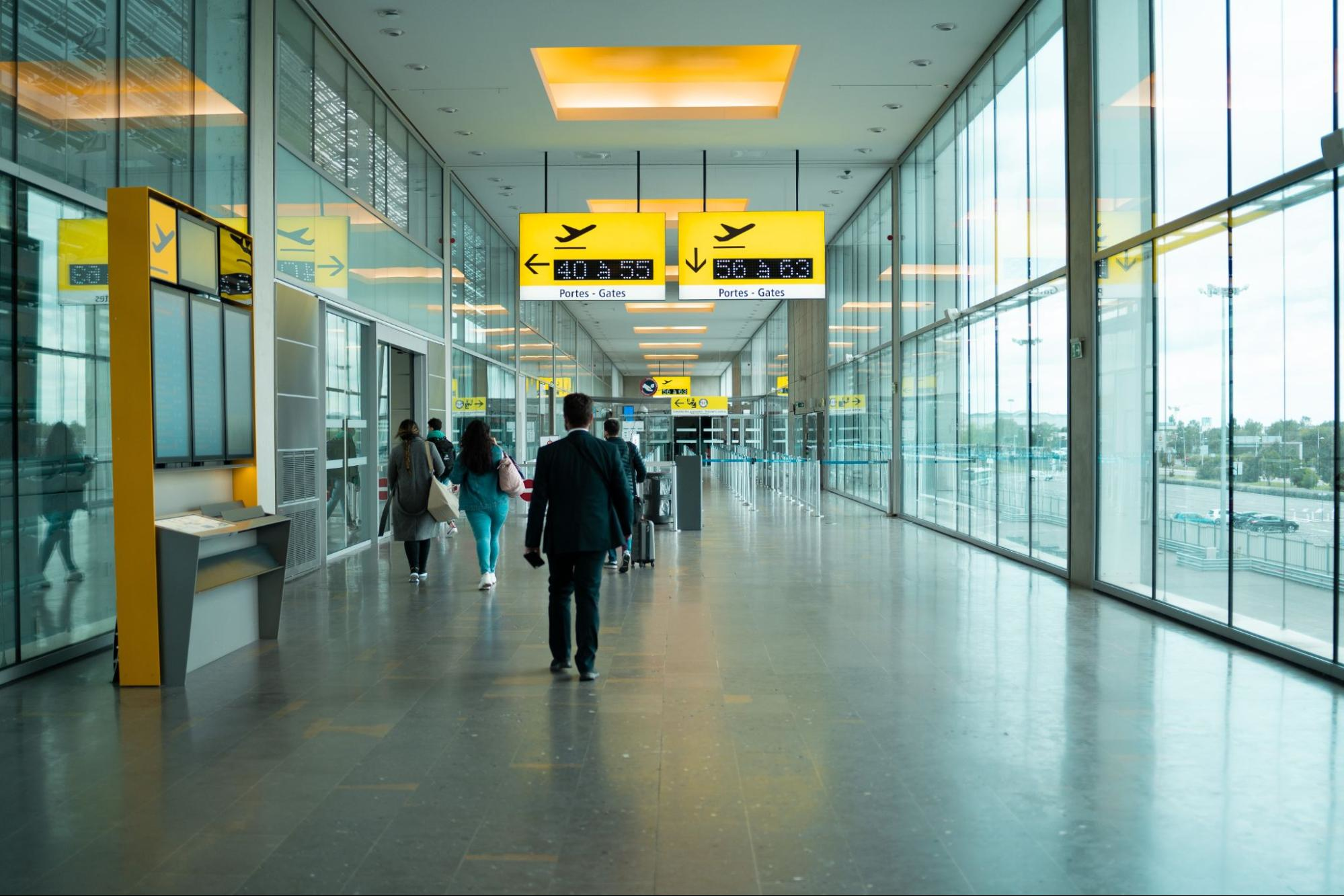Return to Resources
An Introduction to Airport Wayfinding Solutions
May 6, 2024
11 min read
Airports are increasingly operating as smart cities, using advanced technologies to streamline and optimize the management of security, assets, workforce, capacity, commerce, and passenger experience. According to ACI, global passenger traffic will reach 9.4 billion this year. At this volume, airport directors and operations managers are implementing centralized systems to enable efficient and effective mission-critical solutions.
Airport wayfinding solutions enhance both airport operations and passenger experience. By implementing these solutions, operations teams allow passengers to move through the airport with ease despite potential congestion. Often, passengers are not familiar with the airport venue, and wayfinding solutions can lessen their stress and confusion. If they’re already rushing to catch their flight, getting to the right gate should be one less worry for them.
The presence of airport wayfinding solutions also enriches the understanding that airport operations teams have about the venue. Going digital with these solutions allows airport operations teams to easily update and maintain indoor maps to benefit both team members and passengers.
In this blog, we’ll dive into what airport wayfinding is, airport wayfinding solutions and their uses for both operations teams and passengers, types of signage airport operations teams should consider, and how to implement airport wayfinding solutions.
What is Airport Wayfinding?
Airport wayfinding simplifies navigation for travellers, helps improve airport operations and passenger flows, and provides additional context for travellers navigating unfamiliar routes.
For those working in airport operations, they can glean key information from their airport wayfinding solutions. They can study and manage passenger flow through analytics. In doing so, these teams can assure passengers that they can find their route from dropoff to waiting areas and gates in a timely manner, monitor crowds, and distribute traffic flows to improve the passenger experience.

Everybody has different needs while traveling and looking at this information allows for the provision of a personalized passenger experience. By having standardized information and visuals, language barriers can be mitigated, which further reduces passenger anxiety and confusion.
From an airport operations perspective, airport wayfinding solutions aid in both asset and employee management. No matter their level of familiarity, employees should have access to wayfinding solutions to ensure quick and easy movement to locations throughout the venue whether their services or assets are required.
In short, the availability of real-time navigation through wayfinding solutions leads to enhanced airport experiences that start before arrival at the airport and ease of movement for both passengers and airport employees.
Some key inputs to an effective airport wayfinding system are:
Amenities and assistance services
Internal cross-facility transit modes
Landmarks and other visual cues
Parking with defined spaces
Paths connecting locations
Workforce teams such as maintenance and security
Zones or clearly defined areas
Ways to Deliver Indoor Airport Wayfinding Solutions
Airports are getting larger and more inclusive of all sorts of amenities. From the parking lot to departure gates, passengers can explore everything from full-service dining experiences to relief areas for pets, to luxury shopping and spa experiences in today’s airports. The more immediate and personalized that airport operations teams can make airport wayfinding for passengers, the better the overall travel experience will be.
Aside from making the lives of passengers easier, airport wayfinding solutions also present the opportunity to gather real-time data on the pros and cons of the travel experience. As part of the interactions with airport wayfinding solutions, operations teams should consider presenting passengers with easy ways to search and find locations and give feedback to further optimize the airport wayfinding system. This can be offered via touch screens on digital wayfinding kiosks, in mobile apps, and/or sharing maps and routes via QR codes. These digital solutions offer effective ways to collect complaint submissions that need to be addressed.
Map Editing and Updating

In Mappedin’s Content Management System (CMS), airport operations teams can instantly edit maps and ensure accuracy for passengers and help them create, maintain, and update location data such as room locations, amenities, add tenant and amenity branding, and more. CMS is also a powerful tool for large-scale changes to the venue landscape. For example, if an area is going to be closed off for an extended period, airports can indicate that using wayfinding solutions to ensure travelers are routed around it.
Some examples of location data input categories include:
Baggage claim distinctions
Designated areas for pick-up and drop off
Entrances, exits, stairwells, and elevators
Food, beverage, and personal item and services supplier information
In-facility and parking lot transit
Parking lots and space availability
Restrooms and specialized spaces (such as prayer rooms)
Security checkpoint information
Services and assistance locations and assets
Terminal and gate information
Transportation and pick-up locations
Airport Wayfinding Kiosks
Having digital wayfinding kiosks in high-traffic areas such as entrances, boarding gates, and high-traffic areas, airports can provide updates and information before passengers board the plane.
Airport Website Mapping and Mobile Apps
Digital advertisements within wayfinding systems are an excellent way to drive foot traffic and increase revenue for airport shops. These advertisements can show the way to coffee shops, restaurants, convenience stores, and gift shops. Special offers and ads can be updated as needed and for seasonality or tenant-defined sales. Travelers have the opportunity to take advantage of these offerings, and the airport can drive increased revenue.

How to Implement Indoor Airport Wayfinding Solutions
Now that we understand the importance and necessity of airport wayfinding solutions for both airports and their passengers who flow through them, we can dive into how to implement indoor airport wayfinding solutions.
The key steps to take in the implementation process are:
Assess the needs and goals of an airport wayfinding project.
Design the ideal user experience (e.g. web, mobile, kiosk).
Integrate your existing data and system with the new airport wayfinding solution.
Deploy and maintain your airport wayfinding system.
Evaluate the impact.
Both the design and implementation of airport wayfinding solutions are iterative processes. Through digitization, updates and maintenance are made easy for airport operations teams. Let’s dive a bit deeper into this list.
1. Assess the Needs and Goals
Before airport operations teams choose an airport wayfinding solution, members should understand the “why” behind the project. There should be an evaluation of business goals and outcomes, benefits to the internal team, and how the presence of airport wayfinding solutions can enhance the passenger experience.
Although the scope of this project likely falls into the purview of the operations team, there are a number of stakeholders to consider. Business, finance, marketing, and customer service teams should be on board very early in the process so that operations will know how to scope the project including use cases, design, and implementation.
Employees on other airport teams also need to be bought in so that adoption is seen across the board once airport wayfinding solutions are implemented. Adoption, sharing, and use will encourage passengers to use these systems via the web, or through apps and kiosks.
2. Design the User Experience
All passenger experiences are different. Some will have different accessibility needs to be considered, so the information presented through airport wayfinding solutions needs to reflect that.
User-centric design is important. For instance, wheelchair-bound passengers require accessible user interface options on a digital kiosk. In this case, one option is to have indoor map information available that is positioned lower on the screen so that passengers can access the user interface and tap more easily for information, maps, and navigation.
As with physical signage within the airport, make sure that digital labels applied in the airport wayfinding solution are clear and easily understood by passengers and workforce teams. This will communicate information in a more visually pleasing and informational way, quell passenger anxiety, and make it more efficient for airport employees to access maps, provide directions and services to passengers, and locate venue amenities more easily.

3. Integrate Data and Systems
Integrate as much relevant data as possible into airport wayfinding solutions. Although rooted in the notion of an indoor map, an airport wayfinding solution can be so much more. Through custom data integrations, information can be connected and visualized on the map. Flight data and transit connection times provide real-time updates for passengers. Operations teams can monitor security and track assets. Marketing and non-aeronautical businesses can promote and advertise locations on a map to drive revenue. This is a chance for operations teams to go above and beyond between passenger arrival and departure at the airport.

4. Deploy and Maintain the System
Now that the design is complete, it’s time to get the airport wayfinding solutions into the hands of employees and passengers. Start with training employees to promote adoption around system use. Once employees feel comfortable, get the solutions in front of the public. Whether you appoint people on your current airport operations team or employ new ones, there should be individuals dedicated to the ongoing maintenance of the map.
In a venue like an airport, so many things can change at once, and communicating these changes among team members will be essential to the success of airport wayfinding solutions. Employees and passengers should feel like the information being provided to them is reliable.
5. Evaluate the Impact
The metrics that airport operations teams choose to look at are key to understanding the impact of airport wayfinding solutions. Of course, the hope is that all effects are positive, but there is much to learn from negative feedback as well. Some metrics to consider evaluating are adoption rates (how much the system is being used); the volume of feedback (and sentiments within that feedback); passenger experience reviews; and employee feedback.
Top Reasons to Adopt an Airport Wayfinding Solution
Although travelers may be top of mind when thinking about an airport wayfinding solution, the benefits for the airport operations team are crucial. While there are many reasons to consider adoption of an airport wayfinding solution, the following are among the top:
1. Single Source for All Airport Wayfinding and Location Data
Because of the dynamic nature of airport operations, it is imperative that wayfinding and location data with all associated information is centralized so that it is trusted by operations teams and passengers alike. If data is maintained and updated in silos, the output and user experience is fragmented, incohesive, and ultimately inaccurate. One system provides consistency and a single source of wayfinding truth to ensure effectiveness and efficiency across passenger needs and operational requirements.
2. Personalized Passenger Experience
Even though air travel is an inherently shared experience, airport operations teams can still provide passengers with an experience that feels tailored to them and their specific travel needs.
Some examples of personalized information include:
Amenity suggestions
Custom greetings and messages
Dining and beverage options
Gate and flight information
Special deals and offers
Proactively serving passengers with information that they may find useful both enhances their experience with the airport’s brand and encourages them to pour into other businesses that the venue supports.
3. Ease of Data Analysis and Feedback Collection
By continually collecting passenger flow and usage data, wayfinding systems can be optimized for data analysis to track performance and delivery of information, as well as passenger flow.
Collecting and addressing passenger feedback is crucial to the success and reputation of any airport. By presenting a feedback submission option in an airport wayfinding solution, airport operations teams can encourage passengers to interact with them. Showing that the airport is open to feedback in real time builds trust and improves passenger loyalty and experience.
Feedback collection provides passenger intelligence that airport operations teams and other employees can use for better planning to understand areas of improvement and resolve issues that can be addressed more immediately.
4. Delivering Targeted Information
At the core, airport wayfinding solutions are the bridge between airport operations teams and passengers. Operations professionals are constantly seeking efficiencies, and through targeted information, these efficiencies can be passed on to other airport employees and passengers alike. Airport wayfinding solutions can display targeted information that dynamically guides passengers to gates, provides alternative routes if something is happening on the most common route, and more.
Key Takeaways
The presence of airport wayfinding solutions not only enhances the passenger experience but also enriches the understanding that airport operations teams have about the venue
Digitizing your airport wayfinding solutions allows operations teams to maintain indoor maps and instantly make updates for the benefit of passengers
A single source of wayfinding and location intelligence streamlines operations, ensures accuracy, drives efficiency, and gives travelers peace of mind and a positive, loyalty-building experience
Get Started
Contact us to learn more about Mappedin Wayfinding for Airports, book a demo, or to implement this solution across your venues.


